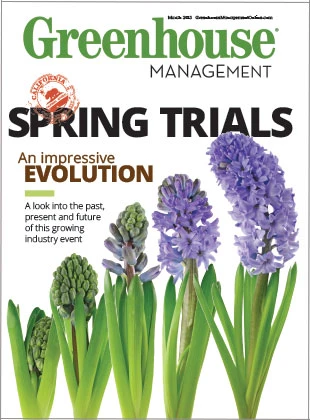|
Some years ago while lunching with other entomologists in California, I noticed aphids on the nasturtium flowers in the salads. All conversation shifted abruptly to identifying the insects (all agreed they were bean aphids), after which the discourse and dining calmly resumed. Aphids are less appreciated by the plant-buying public, which sees them as contaminants that spoil a plant’s appearance. A few kinds even cause physical damage to plants, dramatically distorting leaves or new growth. Growers set tolerances accordingly to maintain aphids at undetectable or extremely low levels during production. Unfortunately, a warm greenhouse environment with well-fed plants and no natural enemies is perfect for aphids, where enormous populations develop even during short bedding plant production cycles. Some aphids are notorious for transmitting plant viruses, though typically this is of minor importance on indoor crops, except in propagation situations.
Foxglove aphid (FA) has become more common in recent years as well. While slightly larger than GPA, they are also pale green with a dark green blotch at the base of each ‘tailpipe.’ FA is often associated with leaf distortion. Cabbage aphid (on flowering kale and cabbage), leaf-curling plum aphid, rose aphid, potato aphid, bean aphid and cowpea aphid are a few of the other species I have seen on greenhouse crops.
Growers are finding that aphid biocontrols can work well given the right conditions. Start when aphid levels are low and environmental conditions are favorable, use no disruptive chemicals and match the biocontrol to the aphid (a diagnostic lab can help if needed). BotaniGard is a formulation of Beauveria fungus spores that infect aphids and may work best when humidity is very high for a day or two. Parasitoid wasps are often used (don’t worry — they don’t bother humans, only aphids). For GPA, Aphidius matricariae is used, while A. colemani is better for MA and will also control GPA and other small species. For larger aphids like foxglove and potato aphids, A. ervi and Aphelinus abdominalis are more effective. Releasing ladybeetles and lacewings and the predatory midge Aphidoletes aphidimyza can be used for a variety of aphid species and may work best combined with Aphidius, especially for melon aphid. Check a portion of each shipment to be sure survival was good, and where chemical applications need to be made, Biobest (www.biobest.be/neveneffecten/3/3/) and Koppert (http://side-effects.koppert.nl/) side effects websites can help determine compatibility. Expect to see sesame-seed like tan (Aphidius) or black (Aphelinus) mummies where aphids used to be. Using biocontrol demands a new approach to management, but some are finding it to be effective and economically reasonable.
Daniel Gilrein is a frequent contributor to Greenhouse Management and an extension entomologist at Cornell University. |

Explore the March 2013 Issue
Check out more from this issue and find your next story to read.
Latest from Greenhouse Management
- The Growth Industry Episode 3: Across the Pond with Neville Stein
- A nation of gardeners: A history of the British horticulture industry
- How Izel Native Plants is solving the native plant conundrum
- Trends: Proven Winners 2025 perennial survey shows strong demand
- Online registration opens for 2025 Farwest Show
- Cashing in with customization
- The Ball Seed Difference
- Lawsuit challenges new H-2 visa rules









